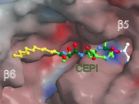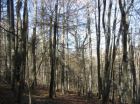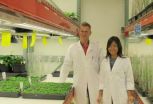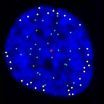Hematopoietic cell transplants serve as valuable treatments for a range of blood disorders, as they generate new, healthy blood cells to replace diseased cells. While cells from related donors offer the highest success rates, similar successes can be achieved using cells from unrelated donors that are available through large registries, such as the the Be The Match Registry® (operated by the National Marrow Donor Program® [NMDP] and Be The Match®), to patients who cannot identify a related donor. Overall participation in HCT donor registries has grown in the last decade, allowing more patients to find unrelated matched donors.
However, the NMDP and Be The Match still face challenges in finding donors for minority patients in need of stem cell transplants. One barrier to matching potential HCT donors with those in need of a potentially life-saving transplant is the fact that patients of non-Caucasian descent often have less common types of human leukocyte antigens (HLAs, protein markers found on immune system genes that determine the compatibility of the donated cells).
According to NMDP and Be The Match data, another important barrier to minority donation for HCT is that when potential minority donors are notified that they are a match for a patient, they are more likely to opt out of registry participation than Caucasian potential donors. During this stage of the donation process (called the CT stage), in which potential donors are contacted for confirmatory HLA typing blood tests and receive information about the medical risks associated with the donation process, Caucasian potential donors are 30 percent more likely than donors of other ethnicities to agree to move forward with donation. This racial/ethnic difference in attrition rates at CT stage has remained a largely unstudied phenomenon.
To better understand why minorities opt-out of a registry and to gauge the influence of race and ethnicity in that decision, a team of researchers led by Galen Switzer, PhD, Professor of Medicine, Psychiatry, and Clinical and Translational Science at the University of Pittsburgh School of Medicine, initiated an observational study with the NMDP. Dr. Switzer and his team conducted telephone interviews with randomly selected Be The Match Registry members who had been notified that they were matched with a potential recipient and had decided either to continue with donation (843 participants) or who had opted out of the registry (224 participants). The sample group included only those participants who had not previously donated stem cells, and represented a range of ethnicities (28% Caucasian, 25% Hispanic, 21% Asian/Pacific Islander, 19% African American, and 7% American Indian).
Based on previous studies, the researchers examined a variety of factors associated with attrition from the registry among individuals of various races, including demographic, cultural (such as religious beliefs and mistrust of the medical system), psychosocial (including anxiety and depression), and donation-related (such as concern about health complications) reasons for withdrawal.
After analyzing the results, the team observed that ambivalence about donation was the factor most strongly associated with potential donors' decision to opt out of the process, a finding that was consistent across all potential minority donors. Dr. Switzer and his colleagues also found that four factors were particularly important in terms of their association with minority group membership and increased risk of attrition: As compared to whites, minorities reported more religious objections to donation, less trust that donations for HCT would be allocated equitably, more concerns about donation, and a greater likelihood of having been discouraged from donating.
In contrast, minorities appeared to be less likely to opt out of the registry if they reported that being a potential donor was an important part of their identity and if others in their social group were aware that they were potential donors.
"The fact that fewer potential donors of minority descent opt to proceed toward donation for HCT when they are identified as a match greatly disadvantages minority patients who are searching for an unrelated donor," said Dr. Switzer. "Our hope is that this study will help registries better understand cultural differences in their donor populations, which, in turn, will lead to the development strategies to maximize potential donor participation."
These results underscore the importance of delivering adequate information to potential minority donors during recruitment to help them fully understand the commitment required and risks associated with donation and will ultimately help ensure patients in need receive a transplant.
"While a patient's likelihood of finding a donor who is willing and able to donate is between 66 and 93 percent, depending on race or ethnicity, the NMDP and Be The Match are committed to ensuring all patients have access to transplant," said Dennis Confer, MD, study co-author and chief medical officer at the NMDP and Be The Match. "This study gives us additional insight into the reasons potential donors become unavailable and solutions to improve donor availability, which is critical to getting a patient to transplant expeditiously."
The researchers suggest several approaches to help reduce the attrition rate, including instituting a "cooling off" period during which donors who initially join a registry take one extra step to verify enrollment, providing them time to determine if participation is right for them. Additionally, a more detailed dialogue between potential donors and registries at the CT stage might help clarify misinformation and ensure that potential donors can make informed decisions about remaining in or opting out of the program.
"Our research team continues to work closely with the NMDP to better understand the experiences of potential and actual HSC donors and to develop strategies to enhance the experiences of registrants from all racial/ethnic groups," said Dr. Switzer. "These strategies should help to reduce the opt-out rates and improve minority patients' access to potentially life-saving stem cell transplants."
###
Editor's Note: The project was funded by grant R01HL081405 from the National Heart, Lung, and Blood Institute (NHLBI), part of the National Institutes of Health (NIH).
Blood, the most cited peer-reviewed publication in the field of hematology, is available weekly in print and online. Blood is the official journal of the American Society of Hematology (ASH), the world's largest professional society concerned with the causes and treatment of blood disorders.
ASH's mission is to further the understanding, diagnosis, treatment, and prevention of disorders affecting blood, bone marrow, and the immunologic, hemostatic, and vascular systems by promoting research, clinical care, education, training, and advocacy in hematology.
Blood® is a registered trademark of the American Society of Hematology. END





